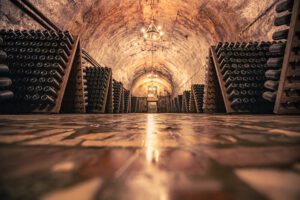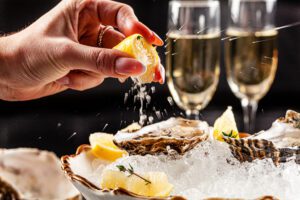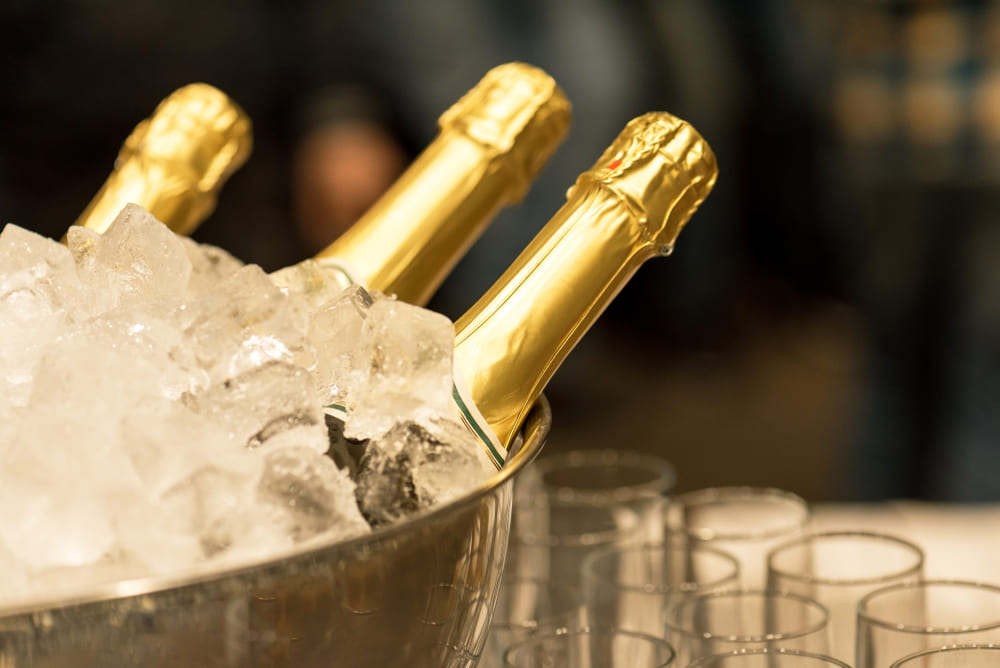Bubbles, Bubbles, Bubbles! Who doesn’t love a glass of bubbly? Sparkling wine is synonymous with celebrations and special events. As we head deeper into the Holiday season, it’s wise to have a bottle of sparkling wine in your cellar. Whether it’s for morning mimosas or an evening toast, a sparkling wine is essential. But it can be a little tricky to navigate which wine to get and what those labels even mean! Let’s break it down!
What Is Sparkling Wine?
A sparkling wine is a wine that has, well, bubbles! Winemakers start by making a still base wine. This is a template for how the bubbles will be added. There are various ways to proceed next, but two methods are the most common. The first is called the ‘Traditional Method’. The second is called the ‘Charmat Method’ or ‘Tank Method’.

Traditional Method
The Traditional Method is utilized by many winemakers. Depending on the country or region, it will most likely say something specific denoting the use of this method. This is how you would see Traditional Method in different languages on other wine bottles.
- Méthode Champenoise (France)
- Méthode Traditionnelle (France)
- Metodo Classico (Italy)
- Método Tradicional (Spain)
- Methode Cap Classique (South Africa)
To break down the process, the first step is to take that still base wine and to place it in a bottle. With the addition of some yeast and sugar, the bottle is sealed and left to rest for a period of time. While the yeast eats the sugar, it produces alcohol along with carbon dioxide, which is what gives the wine its bubbles.
Sparkling wines made in the traditional method will have the standard fruit aromas, but will also acquire notes of biscuits, brioche, and nuts. These are what we call secondary aromas, and they add another layer of depth to a wine.
Champagne is the most well-known of Traditional Method sparkling wines. Many will call all sparkling wine Champagne, which is not technically true. A true Champagne wine hails from the Champagne region of France. Otherwise, it is just a sparkling wine.
One of our favorites is the Champagne Jacques Lorent Grande Réserve. This Champagne is a blend of the three main grapes of the region; Chardonnay, Pinot Noir, and the majority is Pinot Meunier. Grown in the village of Mardeuil, west of Épernay. This wine is labeled Brut and is dry to the taste. It has aromas of yellow plums, apples, pineapple, butter, and brioche. When you taste the wine, you’ll enjoy flavors of cherry, plum, and honey.
We also have Cava from Spain. Cava is made using the Traditional Method along with Chardonnay, which is a popular grape for sparkling wines. Cava will utilize a couple of other grapes including Macabeo, Xarel-lo, and Parellada. Cava is a great value if you love the flavor of Champagne, but don’t want to pay a hefty price. The Vina Palaciega Cava Reserva is a Brut Cava that is a fantastic value and full of all of those flavors similar to Champagne.

Charmat Method
The Charmat Method, also known as the Tank Method, removes the fermentation in the bottle. The second fermentation takes place in stainless steel tanks. This is so the wine does not develop those secondary aromas of brioche and nuts, but rather retain their delicate fruit and floral aromas.
A prime example of a sparkling wine using the Charmat Method is Prosecco! Prosecco is made from the Glera grape and is produced in Northern Italy. When you drink Prosecco, you’ll notice the wine has a lighter body, is fruitier and has floral aromas and flavors. Prosecco rarely has the aromas of brioche and nuts like a sparkling wine made in the Traditional Method.
Many think Prosecco is low quality because it’s available at an affordable price point, and this just isn’t true! The Masottina Prosecco is a prime example of how Prosecco can be a fine wine. Harvested from the famed Conegliano-Valdobbiadene region, this Prosecco is more than just apple and pear aromas. While you do pick those aromas up, you also get hints of plums, pink grapefruit, lime and even some almond.
Sparkling Wine Labels
Reading wine labels in general can be very daunting, but where a sparkling wine label is concerned, it can be even more daunting. Here are some quick references to help you navigate these wine labels!
- Blanc de Blancs: White of Whites or wine made from white grapes only.
- Blanc de Noirs: White of Blacks or wine made from black (red) grapes only.
- NV: Non-Vintage, this is a wine with a year on it as it is a blend of various vintages.
- Crémant: A sparkling wine made in the Traditional Method throughout France.
- Mousseux: A sparkling wine made usually with the Charmat Method throughout France.
- Pét Nat aka Pétillant Naturel: A sparkling wine with the least amount of bubbles.
- Spumante: “Foaming,” a term to denote a sparkling wine in Italy.
- Asti: A region in Northwest Italy known for sweet, sparkling Moscato.
- Lambrusco: A fruity sparkling red wine from Italy.
Dryness/Sweetness Scale
A Traditional Method sparkling wine will have the following terms from most dry to most sweet.
- Brut Nature: Driest with no added sugar.
- Extra Brut: Little to no sweetness.
- Brut: Most common, will typically have some sugar added, but the wine is still dry to the taste.
- Extra-Sec/Extra-Seco/Extra Dry: A hint of sweetness, some describe as off dry.
- Sec/Seco/Dry: Lightly sweet.
- Demi-Sec/Semi-Sec/Semi-Dry: Not a true dessert wine, but would be semi-sweet to moderate.
- Doux/Dolce: Sweetest of all.
Prosecco and other Charmat Method-produced sparkling wines are much simpler with only three. They will say Brut, Extra-Dry, or Dry with Brut being the driest and Dry being the sweetest. Slightly counterintuitive to think Dry would be the sweetest!

What To Pair with Sparkling Wine
A wonderful quality of sparkling wines is its ability to pair with many foods. Sparkling wines perform well at the beginning of a meal to help cleanse the palate. They also pair well with any course in a meal. Choose a lighter sparkling wine like a Prosecco to pair with a salad, or a hearty Rosé Champagne to pair with a steak. Finish your meal with a sweet sparkling wine to pair with dessert such as cheesecake or bread pudding.
Some of our favorite pairings include Champagne and caviar or oysters. A classic and luxurious pairing. We also love to have sparkling wine with fried chicken, potato chips, and really anything fried! The sparkling wine is refreshing when paired with the fattiness of the oil.
We also love to use sparkling wines in wine cocktails, like this Sparkling Moscow Mule Recipe. It works as a great substitute for seltzer and provides more layers of flavor to the cocktail. Follow us on Social Media @thewinecellargroup for more of our cocktail recipes.
Stock Up on Your Favorite Wine Bottles
Whether you’re planning on trying one of our recommendations or you have your own bottle of bubbly ready to go, you can’t go wrong with sparkling wine. Our Cellar Collection features red, white, and rosé, along with sparkling wines from vineyards all over the world. Plus, they won’t break the bank. Browse the collection today or stop by your local Wine Cellar store to pick up a few bottles that will go great with your Holiday celebrations.






Leave A Comment